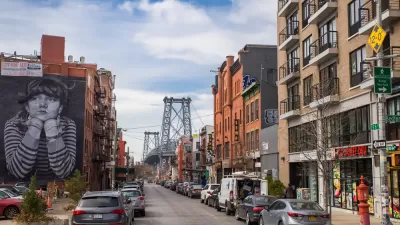As waves of gentrification sweep through the poor and middle class neighborhoods of New York City's outer boroughs, Stephen Smith argues that conservative, and outdated, zoning codes are to blame for the unequal balance between supply and demand.

Although some have taken issue with the extensive rezoning of New York that has taken place during the Bloomberg administration (since 2002, 40 percent of the city has been rezoned), for Smith those efforts have not gone far enough in replacing conservative zoning that keeps neighborhoods such as Williamsburg, Greenpoint and Bushwick "more or less frozen in 1961, when the city's zoning code restricted density and required parking in new construction."
According to Smith, the result of such controls is that as gentrification makes "significant inroads" in Brooklyn and Queens, "the housing that the poor are losing to the rich is not being replaced." And while such "conservative zoning" may be appropriate for "tree-lined blocks of Brooklyn Heights and Park Slope," for functional (misguided attempts to preserve manufacturing) and aesthetic (the houses are "some of the ugliest in the city") reasons northern Brooklyn should allow for more density.
"Zoned out of Williamsburg, Greenpoint and 'East Williamsburg,' gentrifiers have now reached the more densely populated black and Hispanic sections of Bushwick proper. Its poor and middle-class residents, who 20 years ago might have been able to afford apartments just a stop or two from Manhattan in Williamsburg, are now being displaced to neighborhoods like Canarsie, East New York and Jamaica, where they struggle with long commutes. It won't be too long until they're pushed so far from job centers in Manhattan that they leave the city entirely, contributing to the growing sense that New York is too expensive for ordinary people."
"If desirable neighborhoods don't start shouldering more of the burden of increased urban demand," concludes Smith, "American cities will soon end up like their counterparts in Europe, where everyone except the rich and the tourists are shunted off to the suburbs."
FULL STORY: Brooklyn's Affordability Crisis Is No Accident

Alabama: Trump Terminates Settlements for Black Communities Harmed By Raw Sewage
Trump deemed the landmark civil rights agreement “illegal DEI and environmental justice policy.”

Study: Maui’s Plan to Convert Vacation Rentals to Long-Term Housing Could Cause Nearly $1 Billion Economic Loss
The plan would reduce visitor accommodation by 25% resulting in 1,900 jobs lost.

Planetizen Federal Action Tracker
A weekly monitor of how Trump’s orders and actions are impacting planners and planning in America.

Wind Energy on the Rise Despite Federal Policy Reversal
The Trump administration is revoking federal support for renewable energy, but demand for new projects continues unabated.

Passengers Flock to Caltrain After Electrification
The new electric trains are running faster and more reliably, leading to strong ridership growth on the Bay Area rail system.

Texas Churches Rally Behind ‘Yes in God’s Back Yard’ Legislation
Religious leaders want the state to reduce zoning regulations to streamline leasing church-owned land to housing developers.
Urban Design for Planners 1: Software Tools
This six-course series explores essential urban design concepts using open source software and equips planners with the tools they need to participate fully in the urban design process.
Planning for Universal Design
Learn the tools for implementing Universal Design in planning regulations.
Caltrans
Smith Gee Studio
Institute for Housing and Urban Development Studies (IHS)
City of Grandview
Harvard GSD Executive Education
Toledo-Lucas County Plan Commissions
Salt Lake City
NYU Wagner Graduate School of Public Service



























